It’s so simple to describe my process of creating fabric collage quilts that most people get it right away.
- Free-hand cut fabric to shape.
- Glue fabric to foundation.
- Assemble top, batting, and backing, then quilt.
But wait…
Step 2 is glue fabric to foundation? Glue? Really?
Yes, really. I get asked about it at lot and the questions generally fall into one of three categories:
- Why adhesive at all?
- Why glue instead of a fusible?
- How do you do it?
Why Adhesive At All?
The primary reason for using glue is immediacy. Glue allows me to use fabric the way other artists use paint. Grab a piece of fabric, cut it, maybe recut it, pin it, glue it. Done.

My first collages were made of paper while I was in college. I used spray adhesive. I liked collage a lot, even developing a small “library” of images cut from old books and magazines. (Ah, the pre-internet days!)
So when I first decided to try glue as a tool in fabric collage, I used spray adhesive. The quilt of my husband and his two college roommates, “Surprise Me,” was made using spray adhesive. It was what I was familiar with and it worked fine.
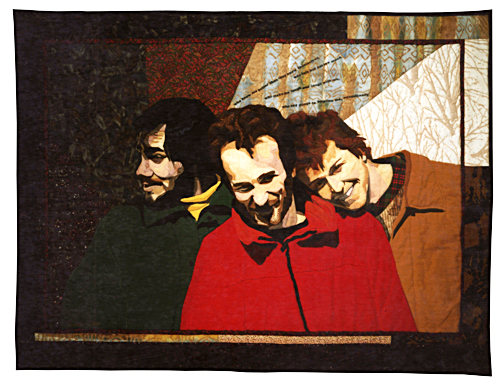
Except I didn’t like the potentially toxic fumes of spray adhesives. If I was going to be doing more pieces, I didn’t want to be breathing that stuff in. I figured that in the long-term it wasn’t the best idea.
Also, it was annoying to pick up each piece of fabric in order to spray the back of it. After spending the time and effort to get a piece cut to exactly the right shape and positioned in just the right spot, I wasn’t crazy about moving it again. (This is the same beef I have with glue sticks, which some students also consider using.)
So that led me to try plain-old, white, craft glue. It’s non-toxic both for breathing and for contact. I soon found that a tiny dab could be smeared on the center of each piece while it’s still pinned in place. Press it down and it’s attached. I had solved both problems.
There are lots of white craft glues out there. The first one I ever used was Aleene’s. I still use it today. Aleene’s has since come out with a whole line of different glues and other adhesive products, but I still use Aleene’s Original Tacky Glue.
I’m sure part of the reason I still use Aleene’s Original is just plain old habit. But it does have two properties I really like. First of all, the consistency seems just right, neither too runny nor too goopy. Second, if applied correctly (more on this later), it dries soft and pliable (more on this later, too).
Why Glue Instead of a Fusible?
Fusibles—iron-on mesh adhesives—have grown in popularity since I began making fabric collage quilts. Many of my colleagues use fusibles. Since fusibles are already in many of my students’ toolboxes, so to speak, they’re curious why I don’t use them.
Again, the biggest reason is immediacy. If while I’m piecing I want to have a dab of red, I rifle through all my reds (and all my fabrics that simply contain red). I have lots of options. But if I have to choose head of time (limiting my options before I even get started), pretreat the fabric, then grab and cut, that’s one step too many for me, for my immediate, serendipitous process.
Besides, I own thousands of fabrics. Some chunks are folded neatly. Other bushels of scraps are stuffed into suitcases. If I wanted to make all of it available to me to use, I’d spend all my time applying fusible instead of actually creating.
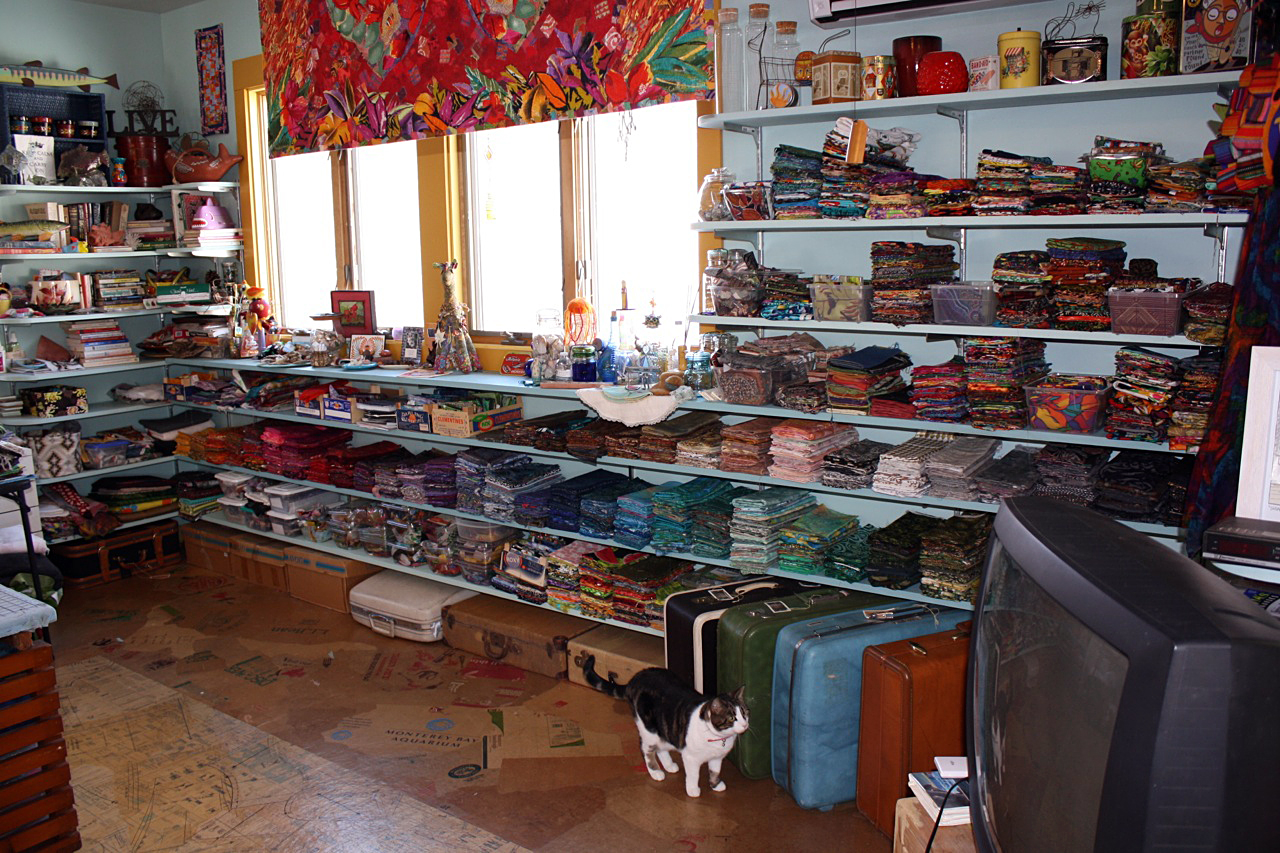
Oh yeah, and tell me which side am I supposed to apply the fusible to? I sometimes use the back side of a piece because it has exactly the shade of color I’m looking for.
Other than immediacy, the other reason I don’t use fusibles is because of how stiff they feel. I apply multiple layers of fabric—four, five, six or more—especially in parts like eyes, mouths and other facial features. Imagine how stiff it would become with four, five, or six layers of fusible added.
When applied properly (more on this later, I promise), glue dries thin and flexible. My quilts still feel like quilts. Despite my untraditional construction and design, retaining that tactile flexibility of fabric is important to me.
Fusibles are great for many applications (no pun intended). My friend Laura Wasiloswki is a member of a group called the Chicago School of Fusing. They do wonderful work. Fusing suits their styles. And isn’t having different styles what it’s all about?
How Do You Do It?
Fabric collage—the way I do it anyway—goes through as many as five stages of permanence, giving me lots of chances to change, remove, cut, cover up, augment, and allow discovery.
- Placing cut pieces of fabric on a foundation.
- Pinning.
- Tacking with glue.
- Permanently gluing.
- Quilting.
When I first cut a piece of fabric, I lay it down on a foundation—muslin or other inexpensive backing fabric. Usually I have sketched my design onto the foundation. When I work on my extended drafting table, I’m working at an angle. Using the cohesion between the fabric and foundation, pieces stay put pretty well just by smoothing them down by hand. When I was working on my pinning wall on “Crocodylus Smylus,” I used white flannel as a foundation. That had even more “stickiness,” allowing me to place fabrics temporarily without even pinning them in most cases.
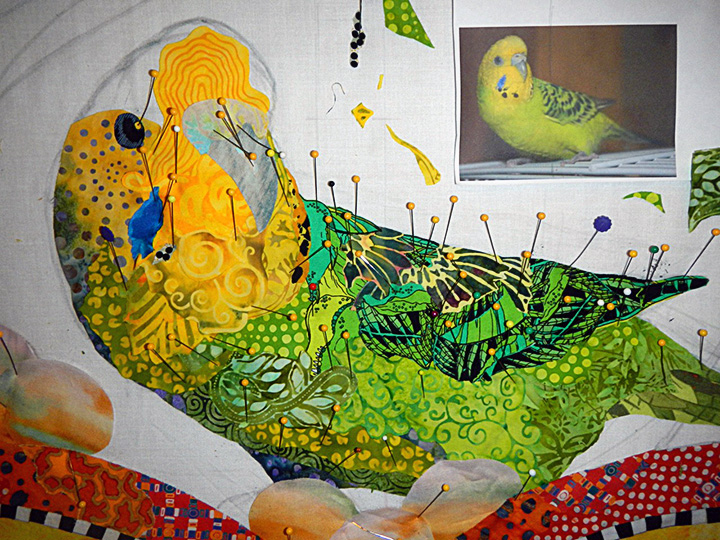
Laying down the fabric on the foundation is the first level of permanence. Next comes pinning. When I can’t put down another piece without risking moving the others, I start pinning. I have adapted my work table with a homosote board. For my pinning wall I used 2-inch thick styrofoam insulation panels. When the work is flowing I’ll sometimes place fabric until I run out of pins. That can mean hundreds of pieces of fabric.
I’ll then have to start gluing.
Aleene’s glue bottle has a nice tip. I simply lift an edge of the fabric and apply a small dab to the center of the piece of the fabric. Notice I said I apply glue to the center of the pieces. I leave the edges loose at this stage. I may want to come back and trim them down or slip another piece under the edge.
Once the dab is in place, I smear it flat. This prevents the glue from soaking through the fabric and creating spots. I use only a small amount of glue, just enough to tack it in place. This makes the piece stable, but still allows me to easily remove fabric if I decide I want to.


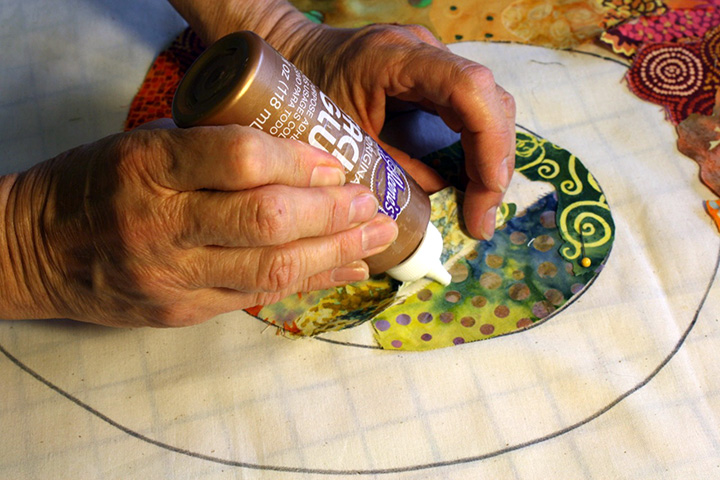
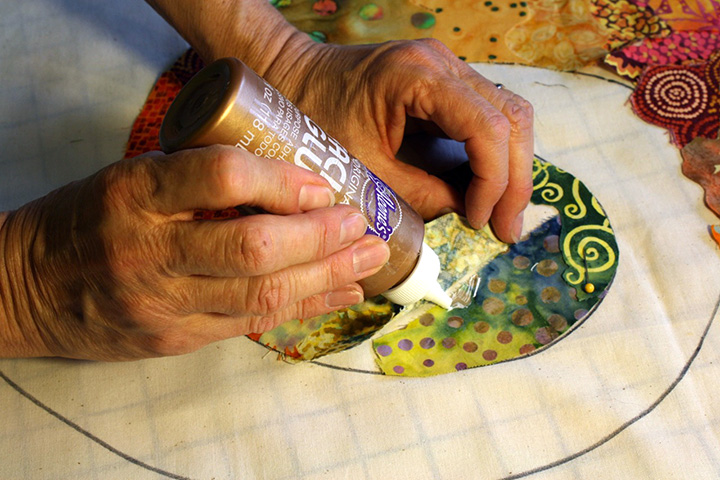
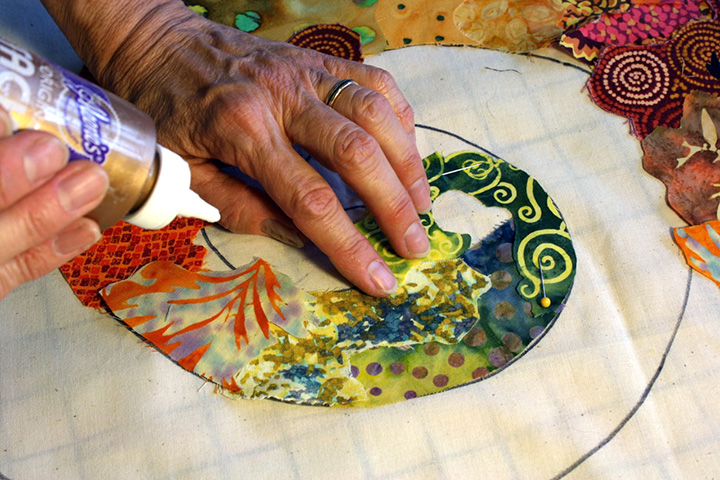
Once tacked in place, it will stay this way until piecing is complete. Before I begin quilting I have a decision to make. Occasionally, I will choose to place a fine netting or tulle over the entire piece. This is called shadow quilting. The netting holds down all the loose edges and prevents the quilting foot on my sewing machine from getting caught.
If I choose not to use tulle (which is most common), I now have to go back and glue down all those loose edges.
Yes, it is tedious. Thanks for asking.
“Dixie Dingo Dreaming” took me three days to glue all the edges.
When this stage arrived for “Crocodylus Smylus” (aka Stevie the Crocodile), I was pretty certain I would use shadow quilting just because the task of gluing seemed so daunting, but my husband, Tom, was against it. I said, “Fine. If you don’t want me to use tulle, you’ll have to help glue.” So he did.
It still took days.
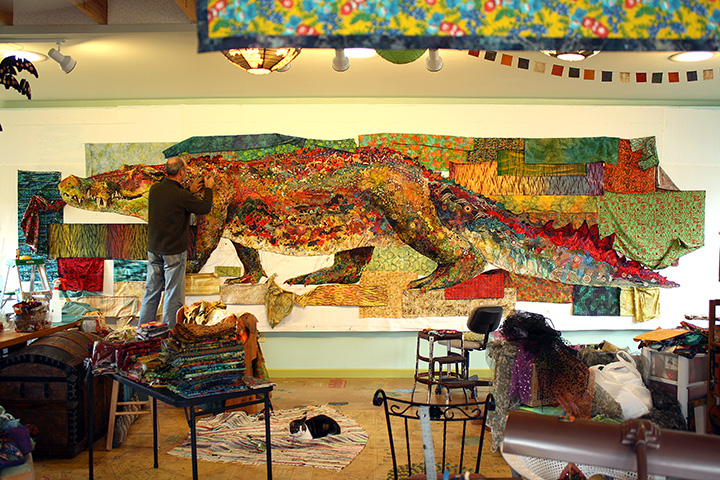
When it’s done, the fabric is permanently attached. It doesn’t move without some real work. Since Aleene’s is water-based, dampening the fabric with a spray bottle can sometimes loosen the glue enough to lift. Usually it’s easier to apply new fabric right over the old if a change is necessary. And, by the way, these collage quilts of mine are not washable. They are art for the wall, not to be subjected to the washing machine any more than a watercolor painting.
Catching all those edges is important to me also because of the way I approach free-motion quilting. I don’t catch every edge when I quilt. Instead I use an overall loopy, spiral, stipple pattern. I aim to hit each piece but not each edge. The glue also prevents fraying, acting a bit like Fray Check without potential discoloration and smell.

Final Thoughts on Glue
So that’s the why and the how of using glue for fabric collage. I didn’t arrive at this way of working overnight. It was more than 26 years ago now that I started gluing fabric. Back then, using adhesives in quilting raised many an eyebrow. I even heard some say that my works weren’t “real quilts.” For some, I suspect, the use of glue is still viewed as “cheating.”
Well, in the last three decades, the rise in popularity of fiber art in general has stretched the definition of what makes a quilt. Quilting is a traditional art with a long and cherished history. The traditional methods of constructing quilts ought to be and are being maintained. But the popularity of art quilts has created an explosion of different techniques and styles. We’re doing things now that would have been unthinkable without experimenting with new ways of creating.
The humble glue bottle has helped me to be spontaneously creative. Of course there are other, possibly even easier ways of using fabric to create art. I see amazing fabric art in shows and on the internet all the time.
Will I ever set aside my glue bottle for a different way of doing things? Hmmm, not in the foreseeable future. But my work, and how I work, has evolved over time, so who knows? I think that staying open to new ideas and trying new paths are key to the creative process. Or I may cling to the way of working that I’ve grown accustomed to. It’s only human nature.

What is important is what works for you. Your art quilts are spectacular and, in the end, speak for themselves. I have used several methods myself and have to adjust based on purpose of the quilt. Fusing works for some things and glue for others, so I make decisions as needed. Thanks for sharing your process.
Thank you for sharing your glue process. I use plain ole elmers white school glue.
Thank you for sharing your process. It’s inspirational.
Thanks so much for such an informative post!! Can’t wait to give it a try!!
Thanks. It’s important to emphasize that if you plan to wash your quilt, remember that glue is temporary. Make sure you quilt it well if you plan to do that.
Fascinating! I love reading about other people’s creative process. Thanks for sharing!
Stevie is amazing.
Thank you for taking the time to talk about the glue. I used spray adhesive one time with 2 fans blowing I still was vomiting for 2 days afterwards. I have used fusible but hate the sticky on my needles when thread stitching and quilting. Some of us have tried using small pieces around our piece just to hold it. I had gone to using my glue pens for paper piecing. Okay, but not really stable while I do my had applique work. So your glue is perfect! I wouldn’t have to put on the edges since I applique them by hand but would hold my piece stable while I work on it.
That’s just what I hope for from my blog. You found something useful and applied it to your own way of working.
Very helpful! Thank you. I have gone crazy using fusibles! Loved seeing Stevie at the Wis Quilt Museum.
Thank you so much for the in depth look at how you create your amazing quilts. I feel like I have learned so much about your process.
Great article and thanks for all your technique shares!!!
I think that it is time that I reconsider the use of glue in my quilting! I have always been a glue “snob”, but if it is good enough for Susan Carlson, it is certainly good enough for me! Thank you for this detailed post as well!
I am learning so much reading your articles. I particularly love the depth of knowledge you share….not just the what but the why and the what else. I’ve used glues and found they dry hard….I think I’m using too much and not smearing enough. More experimenting to follow.
Thanks for being such an inspirational and generous teacher!
You’re very kind.
Excellent process post! Is it Aleen’s Tacky glue you are using?
Thanks. I appreciate knowing more about your process and the glue. By the way I loved your workshop in Lyons!
Thank you for sharing your insights. Great content. I don’t believe there is such a thing as “cheating” in any artform. The creative process is what makes the art, not the method.
Amen.
Great post! I used Aleenes glue in my most recent peice, and it worked great, but then I found out that it is not acid free. Do you view this as a potential problem?
I’ve used it for over twenty years. Not saying it won’t be a problem, Susan, but I haven’t seen any signs of problems yet. Wish I could say the same for sun fading. I’ve repaired a couple quilts because of damage. Have you tried any spray-on UV protection on your quilts? I’m trying to find someone who has experience to see if it works without side-effects of any kind.
thank you for sharing the HOW and WHY of gluing. Since I am venturing more into art quilting and don’t like traditional applique, this is
definitely a technique I was to explore. LOVED Stevie!!
Great article. I am having such a problem quilting on the fusible that I’m going to try the glue on my next project.
Once you’ve made your sandwich, do you have any problems with the machine needle going through the glue when you quilt it??
And remember if you’re going to wash the quilt, glue is temporary.
What machine are you using to quilt your creations, Susan? I, too, have concerns about quilting through all of the layers.
That’s why it’s so important to keep the glue thin. I’ve never had a problem.
An old Bernina. One of the first computerized ones though I never use those functions. I used a longarm machine for the croc quilt.
Thank you for sharing. Love your quilts, love your method. I’ve tried them all and have found myself in a rut of sorts because I didn’t want to go back to fusing everything, want to be able to paint/dye sections then use them as applique, but if I needleturn all those projects, I’ll never get a fraction of the quilts done that I’d like. I wondered if glue might be the answer for me. My first quilts were done with spray adhesive and while fine, I encountered the same issues as you. I’m going to go for gluing and see if I can break free of my rut. I had so much fun before the quilt police told me, “that’s not right”. Going back to having fun and do whatever works for me at the time.
Thank you Susan for sharing how you go about creating your amazing pieces…I have started my journey of creating collage quilting a few years ago and my pieces are getting more complicated and art-like as I journey on but I was struggling with having my work on the dining room table and panicking about the kids and cats wrecking it…I couldn’t prop it up as couldn’t find a quick easy way to fix it….and as my fabric bits get smaller fusible iron on was just spoiling my art flow! I was just thinking about glue but a bit nervous as wasn’t sure if this was ok with quilting and searching the net finally discovered Susan Carlson who creates inspiring art the way I wish to work and is also willing to share and teach her methods to others…that I greatly admire! So please know that this blog and viewing your art is helping my confidence in producing my own artwork & solving little (big) problems on processes while I tinker away in my kitchen slash work room.
Thank you for that Susan and for your honesty. I found it really helpful for me moving forward and thinking about how I want to do my work.
What a great article! Thank you for your detailed explanation of how you make your beautiful artwork. It makes so much sense to use glue. I may have to check this out and chuck all that fused fabric in my stash. …..Well, maybe not all of it. Loved our visit in Australia, Susan.
I just want to emphasize that if you intend to wash your quilt the glue will dissolve. I don’t wash mine ever. But you may want to so make sure it’s quilted.
I’ve been emphasizing that the glue is temporary, but if you’re going to hand appliqué afterward that won’t be a problem.
Yes. It only takes a very little bit of glue and if you smear it as you apply that’s even better. It should soak through at all or create hard spots.
Aleene’s Original. I don’t have a contract with Aleene’s to promote their product however. So use whatever works for you.
Did you see your piece in my blog about the Lyons class?
You go, girl. Do whatever works for you. I think gluing is faster at least in the piecing stage. At the end, I spend a lot of time catching loose edges.
You know I don’t glue right away usually. I work on a surface that allows me to pin into it first. A piece of foam core or styrofoam insulation allows you to fasten those pieces down until you’re happy with them.
Thank you for sharing this technique. I’ve used all kinds of fusible so and like the flexibility of putting fabric right where you want it, but don’t like the resulting inflexibility of the quilt. I’m going to try this with a small piece so I remember how to do it. And glue is so much cheaper than fusible a!
Thank you for giving permission to try this method. I HATE having bins if prefused fabrics that aren’t good for anything else and Misty fuse is lovely but expensive and messy.
Stevie amazing and I’m so glad you made him. Right after Steve Irwin died I wanted to make one in real size but quickly realized it would be beyond me. I hope I get to see yours in person someday.
thank you sooo much for your detailed article. I have recently found that it is easy and quick to use glue. and I have tried it in my Delicate Arch small quilt. I’ll definitely use this technique again, and maybe some day I’ll make a crocodile-size, colourful quilt like yours…
http://hilachayretal.blogspot.com.es/2016/02/el-arco-arch.html
Thank you Susan. I feel inspired to use your gluing technique straight away and let go of some of the more restrictive technical aspects of putting together a piece of work with fusing. How exciting to let my creativity flow with the spontaneous use of colour and textures using fabric and other mediums. You are very generous sharing your vast knowledge and experience.
It’s lovely to read all about your process. I use glue in much the same way on my art quilts and find it the most freeing way to work. For some reason I can’t really sketch but I can freehand cut fabric with no problem. Using glue allows me the luxury of getting right into creating and to get far enough along before I have to make any permanent decisions on my design choices. I will try using the glue around the edges or each piece, as that sounds like a good solution to the fraying that can happen (and is the one drawback of my current method).
That was such a generous share. I am still exploring ways to make art quilt and find that most creators are not usually forthcoming. I am going to try your method on a small piece at least. Have to find some equivalent glue here in India first though!
Susan, there was some conversation on the SAQA list serve about UV spray. People who do public art have used it. Sorry, I don’t remember what they recommended but you could do a search, or ask the question on the list serve.
Have you any problems with bugs? That would be my concern – supposedly, they like the taste of dried glue.
Thanks for sharing this technique, Susan, especially in such detail. I can’t wait to experiment.
Hi Susan, thank you for the detailed and informative post. I love all kinds of appliqué and I have the same grudges against fusible as you describe, in addition I feel it kills the relief in a quilt (I mean the texture, hills and valleys that appear after quilting).
When I do something similar to your process, I either just pin or use glue stick or small bits of fusible web which i just push under my appliqué pieces. This leaves the edges frayed, which I quite like, because I use this method for those pieces where I want the textured edge. I thought about using craft glue, but wasn’t sure it was appropriate for fabric, thanks again for your tips, I must give it a try.
Hi Susan, I admired Stevie at the AQC in Melbourne. I was blown away with the composition and explosion of colour and texture. The West Australians in your class couldn’t praise you enough. I’ve never understood the concept of “cheating” in regards to any art. It’s the dreaded Quilt Police again. Cheating presupposes that there are rules that you must follow without change or innovation. Glue is a tool and you are using that tool to create extraordinary textile art in a manner that differs from others. Not cheating just another art form. Way to go is my thought.
Hello Susan, Thank you so much for the beautiful photos and informative descriptions of your art and processes. In your hands, this truly is art! Stevie is just unbelievable! I also thoroughly enjoy your posts on each place you teach. Australia looked amazing! I hope to see you in Asilomar; yours were the first classes to fill, but I did register in the first few moments that registration went “live”! Fingers crossed here in Southern California…Best, Juliet
Hello Susan, Thank you so much for the beautiful photos and informative descriptions of your art and processes. In your hands, this truly is art! Stevie is just unbelievable! I also thoroughly enjoy your posts on each place you teach. Australia looked amazing! I hope to see you in Asilomar; yours were the first classes to fill, but I did register in the first few moments that registration went “live”! Fingers crossed here in Southern California…Best, Juliet
Hi Susan, I took your class a couple years back in Grand Island, your glue technique has changed the way I quilt. I love doing collage quilts!
I absolutely love your detailed description of your process. I have followed you through book, magazines and The Quilt Show and maybe even farther back than that when you had your yurt. I would love to know how you quilt your work Is it pre-planned and drawn out or spontaneously created as you go? Any tips for keeping your work straight or hanging flat after it travels boxed up?
Excellent article. I always use fusible web and decided to use glue after reading this. It was so freeing! Thank you!
You are so generous to share your methods. Love your work and so appreciate you!
Your work is amazing! Thank you for sharing your technique. I am an emerging mixed-media textile artist and I have experimented with using glue to hold my fabric elements in place but I find they ruin my needles really quickly. Have you experienced this proble too Susan?
I use very little glue to hold the pieces in place. Also the type of glue doesn’t stay sticky at all. It dries completely but stays flexible. So, no, I don’t have trouble with ruining needles.
I love you quilts, I have never quilted before and I am watching your videos and others to learn. Can you combine your technique with gluing pieces of fabric together then place on the iron on fusing? Has anyone tried this. I want to make a usable quilt out of my mother’s clothes? Any help would be appreciated.
I don’t want to disappoint you but this is not a technique for making usable quilts. There are too many raw edges, plus I use water-soluble glue. It wouldn’t stand up to washing at all.
So glad to read this. I have been using tacky glue for a while in collage type projects…cards, bookmarks, little pictures, with some light quilting and securing with the sewing machine after. I do a lot of lace collage (and found the glue will not adhere to nylon lace!) The tacky glue will also give good adhesion to light buttons and charms I like to make pieces that can be enjoyed in the present. I will leave the heirlooms to other people!
I feel exactly the same about using glue in the process of creating a collage, but up to now I was always confused and tempted to change my method and use fusibles instead because I consider myself a beginner with next to no knowledge about the ‘correct’ way to a proper
fabric collage. Now, however I’m highly motivated to continue my interrupted journey into fabric collaging. Thank you so much.